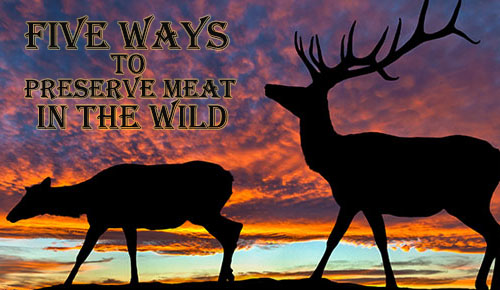Unfortunately, many people are unaware of how to preserve meat without a refrigerator and have completely forgotten how our grandfathers preserved their proteins. If you are stranded in the wild, it is important to act fast to preserve the meat. In fact, it can start to go bad in as little as a few hours.

Luckily, there are a number of food preservation techniques for preserving meat in the wild. Here are several techniques that I feel are especially effective:
Five Ways To Preserve Meat In the Wild
Wet Curing Meat
One way to cure meat is to use a saltwater solution with 15-20 percent salt. Place small cuts of meat in this solution, and let it soak for around five minutes. Then, take the meat out of the solution and hang it out to dry.
You shouldn’t hang the meat in a sunlit area. This can result in certain parts of the meat curing more quickly than the rest. Also, the area that you choose for drying must be well ventilated. The hooks that you use for the drying process must be made of materials that will not rust.
The curing process usually takes around five days. During this period, it is unlikely that you will have any issues with insects in the meat. The salt naturally repels them.
Dry Curing Meat
Dry curing meat is another effective way of preserving it. When you use this method, the salt is rubbed over the meat and it’s dried. You also can add other flavorings to the dry rub, such as pepper or other spices.
What To Do After It’s Cured
After either curing process is finished, the meat can be rehydrated if it’s cooked by boiling. After boiling the meat, the nutritional content is nearly unchanged. While I don’t find boiled meat to be particularly tasty, this method is highly effective at preserving meat. However, it’s essential to store the meat in an environment that is dry.
Smoking Meat In The Wild

If you smoke your meat, you’ll be able to enjoy a savory, barbeque flavored meat in the wilderness. The longer it’s smoked, the longer the shelf life is likely to be. When meat is smoked overnight, it’s likely to remain good for a week. However, two days of constant smoking can allow meat to last for anywhere between 2-4 weeks. I feel that the only downside to smoking meat for a long period of time is that the smoky flavor tends to be stronger.
Find green wood or dampen the wood you use for the fire. When you are smoking meat, it is the amount of smoke that is more important than the fire. However, avoid wood that is resinous.
Do you long for that authentic smoked bacon? Or the taste of juicy mouthwatering ham and link sausages that you just don’t find on supermarket shelves? Well, if you want to enjoy all that and feel like a kid again, waking up in your grandma’s house… while ensuring your family is well fed no matter what the future brings, then…read THIS!
It’s also important to cover the fire. There are a couple of ways to do this. One is to dig a hole in the ground and drape a poncho, sheet, part of a parachute, or other covering over the fire, but you can also create a ‘teepee’ surrounding the fire. The meat should be cut into thin slices, and the strips should be around 6 centimeters thick. Additionally, the meat should be placed high enough above the fire so that it’s smoked rather than cooked.
After the meat is smoked, it should be dry and quite brittle with a curled appearance. It also shouldn’t feel cold to the touch. When it’s done, the meat can be eaten without being cooked.
Freezing Meat
If the temperature is below freezing, simply leaving the meat outside can be essentially the same as bringing a working freezer with you into the wilderness. Frozen meat is well preserved until it thaws. However, the meat must be cooked after thawing to avoid food poisoning.

Making Jerky In The Wild
In order to make jerky, you can place meat on a rack over a flame for the drying process. It’s important that the meat racks are not too close to the flame to ensure that it’s dried rather than cooked. Over time, the smoke will turn the meat into jerky. This will happen faster if you cover the fire. Below you can watch a video that goes into more detail:
However, you can make jerky without using a fire if the meat has been cured before you begin drying it. If the meat is hung inside a box while being dried using a fan,  you can get exceptionally tasty jerky that’s safe to eat even if you eat some before it’s been fully dried. I find that the taste of jerky made this way is far better than jerky that is available in stores.
you can get exceptionally tasty jerky that’s safe to eat even if you eat some before it’s been fully dried. I find that the taste of jerky made this way is far better than jerky that is available in stores.
Want to learn how the first settlers survived the wild west ?
Then you really need this amazing book. It is called The Lost Ways and it contains all the knowledge of our forefathers.
Here’s just a glimpse of what you’ll find in The Lost Ways:
From Ruff Simons, an old west history expert and former deputy, you’ll learn the techniques and methods used by the wise sheriffs from the frontiers to defend an entire village despite being outnumbered and outgunned by gangs of robbers and bandits, and how you can use their wisdom to defend your home against looters when you’ll be surrounded.
Native American ERIK BAINBRIDGE – who took part in the reconstruction of the native village of Kule Loklo in California, will show you how Native Americans build the subterranean roundhouse, an underground house that today will serve you as a storm shelter, a perfectly camouflaged hideout, or a bunker. It can easily shelter three to four families, so how will you feel if, when all hell breaks loose, you’ll be able to call all your loved ones and offer them guidance and shelter? Besides that, the subterranean roundhouse makes an awesome root cellar where you can keep all your food and water reserves year-round.
From Shannon Azares you’ll learn how sailors from the XVII century preserved water in their ships for months on end, even years and how you can use this method to preserve clean water for your family cost-free.
Mike Searson – who is a Firearm and Old West history expert – will show you what to do when there is no more ammo to be had, how people who wandered the West managed to hunt eight deer with six bullets, and why their supply of ammo never ran out. Remember the panic buying in the first half of 2013? That was nothing compared to what’s going to precede the collapse.
From Susan Morrow, an ex-science teacher and chemist, you’ll master “The Art of Poultice.” She says, “If you really explore the ingredients from which our forefathers made poultices, you’ll be totally surprised by the similarities with modern medicines.” Well…how would you feel in a crisis to be the only one from the group knowledgeable about this lost skill? When there are no more antibiotics, people will turn to you to save their ill children’s lives.
And believe it or not, this is not all…
Table Of Contents:
Making Your Own Beverages: Beer to Stronger Stuff
Ginger Beer: Making Soda the Old Fashioned Way
How North American Indians and Early Pioneers Made Pemmican
Spycraft: Military Correspondence During The 1700’s to 1900’s
Wild West Guns for SHTF and a Guide to Rolling Your Own Ammo
How Our Forefathers Built Their Sawmills, Grain Mills,and Stamping Mills
How Our Ancestors Made Herbal Poultice to Heal Their Wounds
What Our Ancestors Were Foraging For? or How to Wildcraft Your Table
How Our Ancestors Navigated Without Using a GPS System
How Our Forefathers Made Knives
How Our Forefathers Made Snow shoes for Survival
How North California Native Americans Built Their Semi-subterranean Roundhouses
Our Ancestors’Guide to Root Cellars
Good Old Fashioned Cooking on an Open Flame
Learning from Our Ancestors How to Preserve Water
Learning from Our Ancestors How to Take Care of Our Hygiene When There Isn’t Anything to Buy
How and Why I Prefer to Make Soap with Modern Ingredients
Temporarily Installing a Wood-Burning Stove during Emergencies
Making Traditional and Survival Bark Bread…….
Trapping in Winter for Beaver and Muskrat Just like Our Forefathers Did
How to Make a Smokehouse and Smoke Fish
Survival Lessons From The Donner Party
Get your paperback copy HERE
CHECK OUR survival and prepping solutions
If you found this article useful, please like our Facebook page and stay up to date with the latest articles.
WHAT TO READ NEXT:
HOW TO MAKE YOUR OWN BACON (STEP BY STEP GUIDE)
A RETURN TO THE OLD PATHS: HOW TO MAKE PEMMICAN LIKE THE NATIVE AMERICANS
20 LOST RECIPES FROM THE PIONEERS: WHAT THEY COOKED ON THEIR JOURNEY WESTWARD
SEVEN CLASSIC GREAT DEPRESSION ERA RECIPES GRANDMA USED TO MAKE
POTTED MEAT: A LOST SKILL OF LONG TERM MEAT STORAGE
BACK TO BASICS: HOW TO MAKE AND PRESERVE LARD
THE BEST WAY TO STOCKPILE VEGETABLES OFF-GRID
OLD FASHIONED PRESERVING-GRANDPA’S RECIPE FOR CURED SMOKED HAM
HOW TO MAKE GUNPOWDER THE OLD FASHIONED WAY
SURVIVAL HERBAL RECIPES FROM OUR ANCESTORS
HOW TO PRESERVE MEAT FOR SURVIVAL LIKE OUR GRANDFATHERS
OTHER USEFUL RESOURCES:
The 3 Pioneer Survival Lessons We Should Learn
The Most Effective Home Defense Strategies
Old School Hacks for Off-Grid Living
The Medical Emergency Crash Course

An impressive share! I have just forwarded this onto
a coworker who had been conducting a little research on this.
And he in fact ordered me dinner due to the fact that I stumbled upon it for him…
lol. So let me reword this…. Thank YOU for the meal!! But yeah,
thanks for spending time to discuss this subject here on your website.